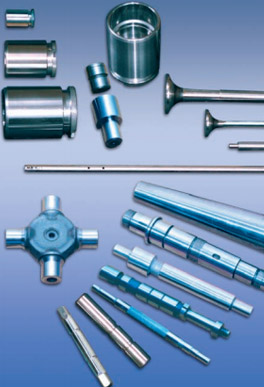
Of the many factors affecting the quality of surface finish obtainable on centreless ground work, first consideration should be given to the material from which the wearing surface of the blade is made. The principle blade material is recommended: Sintered Carbide.
These blades are recommended for the majority of the materials to be ground. While the Sintered Carbide blades are higher priced, fewer re-grindings are required; thus the blade cost per ground piece is lower than that of any other blade material. The finish of the Carbide work surface on the workrest blade is of paramount importance, to enhance longer life and reduce the number of set-ups. It is strongly recommended that the Carbide surface has a high gloss mirror finish. This will reduce the friction between the work piece and blade thus giving a high class finish and longer wear life of the blade. A wide variety of work material may be success fully ground on Sintered Carbide blades.
The angular top work blade is applicable to most centreless operations. Several considerations determine the steepness of the angle. For example: a blade with too steep an angle produces a great horizontal force on the blade, resulting from the pressure on the work created by the grinding wheel. The horizontal component of the grinding pressure between the work and wheel, which increases as the angle increases, must be resisted by the blade itself. It is therefore, usually advisable to reduce the top angle of long blades, as a long, narrow blade offers only a small lateral resistance to chatter.
Work of a given diameter and length may be ground with 4" wide wheels on a 30° angle blade with no difficulty, but if the length of the work and the length of the blade or the width of the wheels is increased, the top angle should be reduced to 25° or 20° in order to decrease the side pressure on the blade. For the same reason, the larger the diameter of work piece to be ground, the smaller the blade angle required.
The length of the blade is determined by the width of the wheels, while the thickness of the blade is determined by the diameter of the work. The work supporting part of the blade should be slightly thinner that the work diameter. For large diameters blades of maximum thickness should be used.
Generally speaking, work is ground with its centre above the centreline of the wheels. A good rule to follow is to set the centre of the work approximately one-half of the work diameter above the centreline of the wheels and to decrease or increase this amount as the grinding results require. However, only on rare occasions does the elevation of work above centres exceed 1/2". The limit to which this height may be increased is governed by the tendency of the work to vibrate and mar the finish.
After the blade has been set to the approximate height and the wheels are mounted and properly dressed, adjust the upper and lower slides until the work is in the correct position (as when grinding) in relation to the blade and the wheels. Then adjust the work guides on the regulating wheel side of the work rest to line up accurately with the surface of the wheel. Now bring up the opposite guides to within about 1/64" of the work, depending upon the roundness and variation in size. After completing the set-up, clamp the top slide to the lower slide. The workrest and the regulating wheel can then move forward as a unit to compensate for grinding wheel wear. Clamp the lower slide to the bed and adjust the upper slide unit to compensate for regulating wheel wear.














